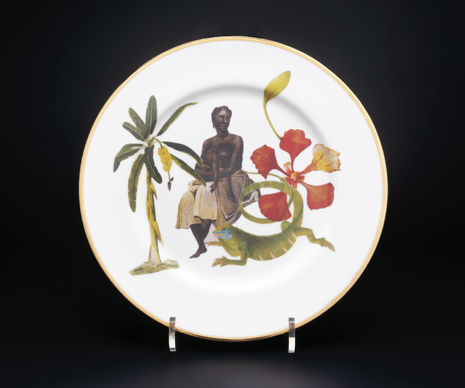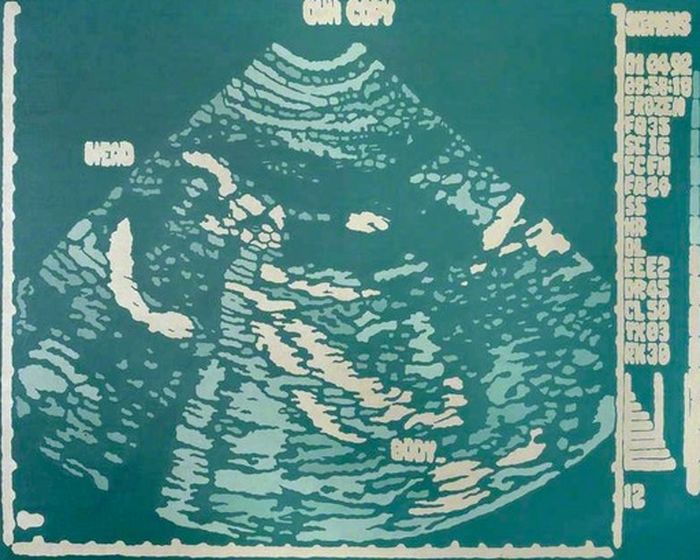‘Black Atlantic: Power, People, Resistance’ at the Fitzwilliam Museum
Bringing to light stories that have been silenced, ‘Black Atlantic’ confronts the Fitzwilliam’s historic connections to the transatlantic slave trade

A black rock behind glass, sooty and amorphous, yet sparkling with the suggestion of mica crystals within. This was one of the first objects I encountered in my visit to the Fitzwilliam’s latest exhibit, ‘Black Atlantic: Power, People, Resistance’, at once startling and opaque. The rock, contoured with the harsh abrasions of having once been struck, seemed to curl in on itself. Like dark keloids, I could recall in its bumps and clefts the cliffside where the segment was first taken from, brought back from the Canadian North by the English slave-trader Martin Frobisher in the late 16th century. He, too, was enticed by its lucrative shine. However, exposing a colonial hubris, Frobisher’s claim that the earth was mixed with gold and silver ended up profitless. The sequins encased in the rock’s vague form are merely common minerals. Fool’s gold, perhaps.
This charred geological form, smirking and glimmering with false riches which flirt from within, holds a different kind of value now. The winks of lustre have become a kind of hoodwinking under the gallery’s illumination, and I began to see the exhibit in a suddenly new light. ‘Black Atlantic’ takes the stuff of empire – portraits and compasses, sculptures and sediment – and radically reorients them. It presents a series of quiet rebellions, not insistent but probing and subtle, using the language of conquest against itself. This, then – its attempt to restore a balance by pointing back – is where I find its ore.
"It presents a series of quiet rebellions, using the language of conquest against itself"
Imbalance is referenced, with a guilty sort of expression, at the very entrance of the exhibition. As an outcome of the 2019 discussions on the Legacies of Enslavement, initiated by Cambridge’s then-Vice Chancellor Professor Stephen J. Toope, ‘Black Atlantic’ must first nervously announce its origins: a curation housed in a museum that was built off the profits of the slave-trade. Two portraits stand to represent this admission. They have been made into a diptych, and in balancing them the exhibit makes clear their tonal contrasts, (not only of colour). One is of Richard Fitzwilliam, whose donation in 1816 was used to build, and continues to support, the museum. The other is of an unnamed black man, whose identity has been ‘lost or was never recorded.’ In placing these portraits together, ‘Black Atlantic’ poses an important question in white font: ‘Who gets remembered and why?’

I thought about how art and sculpture – two very visual modes – are able to enforce invisibility. Early on in the exhibition, I came across a marble relief from 200 CE, depicting rows of chained, near-naked men led by soldiers, presumably to fight with the lions which haunt and hunger below. The captives have been chipped out of a larger block of stone – half-in and half-out – keeping them imprisoned in the very form they are made from. The slaves are made truly marginal – only thinly textured and barely formed. Half of the sculpture, it seems, has broken off since its creation, leaving it top-heavy. The irony does not escape me; time has only enforced this hierarchical imbalance.
Where I had expected portraits and landscapes, ‘Black Atlantic’ offered a more tangible experience, curating the objects of slavery and allowing their silence to speak for itself. A sense of uncontested white supremacy is heralded in these items: a Dutch jar (c.1750-1820), for instance, depicts two men smoking on a Cuban dock, languishing about the barrels of tobacco leaf which they will soon ship off. I circled the crock, but found only one perspective. The African bodies enslaved to procure the tobacco are out of frame – here we find only a lazy, tropical still. Another item, a bell, speaks through a similar sort of irony. Once used to signal the start and end of a slave’s work day on a sugar plantation in Demerara, the instrument was donated to the front court of St. Catherine’s college in 1960, where it was rung on Armistice Day until its removal in 2019. The bell is a symbol of unbridled announcement, and yet it has omitted the voices of its origin for almost a century. It has drowned them out, overpowering with its blithe and dominant peal.
"‘Black Atlantic’ reaches a crescendo when addressing this re-appropriation"
When people are seized from themselves, their voices stamped out or ignored, the subjugated must take on a different voice in order to be heard – often the voice of the powerful. I find that ‘Black Atlantic’ reaches a crescendo when addressing this re-appropriation. Barbara Walker, for instance, creates a series of palimpsests, reimagining several historical paintings from the marginalised perspectives which they first obscured. She carefully renders the black figures while merely embossing the white ones, leaving them to the limbo of a negative space. Walker is not merely centring black bodies; she is unleashing them from obscurity, revealing their blackness and rendering whiteness, by contrast, as threatening and dark.
Keith Piper, too, gestures a way forward by echoing back. The links of the slave trade are not merely shipping routes drawn across two dimensional seas, but lines connected through time to our own. In a sequence of panels titled ‘Go West Young Man’ (1987), Piper takes the stowage plans of slave shipment - the cool, distant, mathematical engine of white supremacy – and ironically reverses the colonial call to ‘Go West’. Here, African bodies are stacked on top of each other, diluting the individual. He pairs personal photographs with Hollywood film and images of men being lynched, collaged amongst chunks of letters to ‘Dada’ which profess the struggle and commodification of black identity: ‘I began to picture myself as they (hoped) to see me.’ Separated by white frames, a sense of stiltedness pervades. I could see only fragments of bodies distributed through the series – a back, a foot, a finger. In the centre, a black man is divided in half, cutting out his genitalia: ‘These people can’t see me without seeing my potential for miscegenation’, Piper writes. The images mark a clever duality, highlighting a sense of social castration while being reproduced over fourteen frames. Piper is angry and the canvases grit together like two rows of teeth, but they are far from silent.
As a term, ‘Black Atlantic’ refers to the matrices of African culture spanning across an oppressive empire, as well as the afterlife of enslavement which still reaches into the present day. The idea was extended by Paul Gilroy in his book The Black Atlantic: Modernity and Double Consciousness (1993), where he argued that black culture, following diaspora and the international slave trade, has no bounds. Blackness transcends one plane or space; it wields a capacity for infinite re-imagination. By the end of the exhibit, I think I see his point best expressed in the work of Alexis Peskine, whose stoic, confronting portrait is sculpted from nails – tools used to ‘perforate and puncture but also construct and create.’ Behind him, a halo of golden light diffuses out. It belongs to no fool. Blackness is here illuminated, brought to light after so long spent in the dark.
‘Black Atlantic: Power, People, Resistance’ is open at the Fitzwilliam Museum until January 7th 2024.
 Comment / Plastic pubs: the problem with Cambridge alehouses 5 January 2026
Comment / Plastic pubs: the problem with Cambridge alehouses 5 January 2026 News / Cambridge businesses concerned infrastructure delays will hurt growth5 January 2026
News / Cambridge businesses concerned infrastructure delays will hurt growth5 January 2026 News / Cambridge academics stand out in King’s 2026 Honours List2 January 2026
News / Cambridge academics stand out in King’s 2026 Honours List2 January 2026 Interviews / You don’t need to peak at Cambridge, says Robin Harding31 December 2025
Interviews / You don’t need to peak at Cambridge, says Robin Harding31 December 2025 News / AstraZeneca sues for £32 million over faulty construction at Cambridge Campus31 December 2025
News / AstraZeneca sues for £32 million over faulty construction at Cambridge Campus31 December 2025










